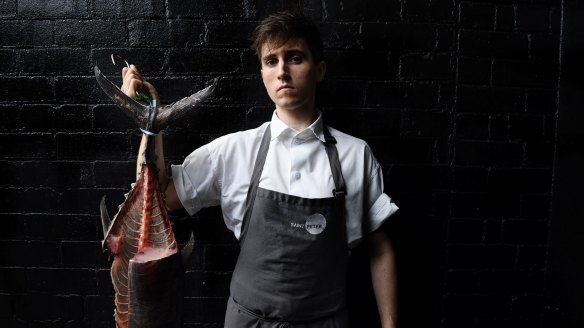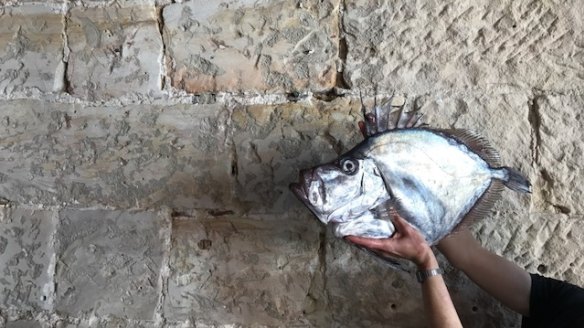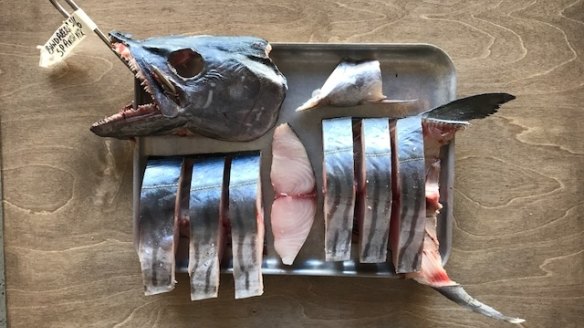How Saint Peter chef Josh Niland is changing seafood cookery

As chef, fish nerd and boundary-pusher, Josh Niland has had his fair share of Absolutely Nots. But like anyone ground-breakingly innovative, he long ago learned the power of the middle finger.
From his Sydney restaurant Saint Peter (the national Good Food Guide's New Restaurant of the Year), home to the most interesting and experimental fish cookery in the country, Niland is creating a new way to view seafood. At 29, the singular chef has devoted his entire working life to fish – from gill to tail. Here, he and his team cures wild kingfish livers and calamari semen. They collect kelp from the beach and use it for kelp vinegar. Nothing, if they can help it, goes to waste. The blood (to make a fish boudin noir), skin (to be boiled, dried, deep-fried then used as a garnish) and eyeballs of a mirror dory are treasured as highly as the fillets. It's unlike anything else, well, anywhere.

"I don't know of anyone doing anything [with fish offal] to this extent," says Niland. And yet, despite a very niche brief – the Paddington restaurant serves no other protein – he's attracted a loyal following way beyond the textbook hard-core restaurant fanatic. Possibly, in no small part to his accidentally beautiful Instagram account, with 24,000-plus followers and rising, which he modestly credits to nice lighting and a very attractive subject matter. "If a beautiful fish comes in, you have to photograph it," he says.
But there are times when that can backfire, too. There are no shortcuts when it comes to fish butchery – something that can be missed when caught up in the romance of a brilliant Instagram shot.
"It frustrates me when people go and do all the extreme stuff we're doing without having even bought the whole fish," says Niland. "That's defeating the purpose. My supplier Tony Wearn (Nicholas Seafood) gets calls now from [chefs] who say 'Hey, Josh has john dory livers on at the moment. Can I get four kilos?' And he'll be like, 'Josh had to buy 24 kilos of dory to yield the four livers he put on Instagram'. People are asking for fish hearts so they can cure big batches. They're asking the guys to sift through their gut bin at the markets and snip out all the hearts."

Niland's dedication to sea creatures is a product of his years training with Peter Doyle at Est. and Steve Hodges at Fish Face. In that time, he narrowed his focus, sharpening the fine-dining skills he learnt from Doyle against the steel of Hodges' unrivalled seafood expertise.
Working at the tiny Darlinghurst seafood restaurant with the famously hot-tempered and mercurial chef, Niland would often experiment with fish offal. Not that Hodges was all that interested in preserving kingfish hearts or stuffing swim bladders. "I was always doing it and Steve would say 'f--- off with your bits'. He was never keen."
It was here that Niland also learned the art of butchering a whole fish. "Breaking down a whole fish for the first time was a frightening feeling, just because the expense was drummed into me. Also, I wasn't allowed to cut the big stuff straight away because we had all those really great sushi chefs. [Fish Face chef] Koji Nakamura went back to Korea and is on Korean MasterChef now – he's a really big deal over there. I always give Koji credit for me being able to do this."

It was also where he learned about dry-aging fish – something Hodges was doing more than a decade ago, though it didn't have a headline-grabbing name back then. Niland, however, has developed his own way of getting those savoury, complex results in his cool room, utilising a few meat butchery techniques. "It's just about putting the fish in a room in the right conditions but not letting it lay down because then it sweats and sits in its own moisture. So we hang it. The last part of the process, which is the most different and special we do here, is we put the fish in the cool room in front of the fan for the last two days of aging, which dries the skin and allows us to replicate pork crackling."
He once hung an entire albacore for 41 days – the longest project he's done to date. The difference between day one and day 41, he says, were palpable. "By day 41 it had lost so much of its moisture, all that was left was the albacore fat. You're eating it with the intensity of mojama [cured, dried tuna] but it's raw fish. It's hard to articulate what albacore tastes like because it's so boring but when you take all the moisture out and then eat it, it's like 'f--- me, that's what albacore tastes like'. And then when you eat it, as a chef you can start to put it with things you'd never have thought to put it with before."
The end game for him was always to own and run a restaurant devoted to fish. Doing anything else, he felt, would have felt disrespectful to Hodges, who gave so much of his time and energy to training the young chef. "When I left Fish Face, I said to Steve, 'the gift of the cooking, the technique and the skills, you can't buy that. You can't go to a school and learn that. There's only one you.' I think everybody would be the first to put their hand up to say he is the best." When Hodges came into Saint Peter for the first time just over a month ago, Niland says he "absolutely went to shit".
"This was the guy who inspired me to want to devote myself to fish. I didn't know he was coming. It was wild. I just really wanted to show him all the things we never did at Fish Face. It was nice to give him details that he taught me in the context of this place."
Starting off with just three chefs in the kitchen, opening the doors to Saint Peter was no easy task. "It was a nightmare," says Niland. "Everyone was broken and couldn't give anything more, just turning up because they had to be here." Today, he has eight dedicated Aussie chefs boasting experience from everywhere including Sixpenny (Sydney), Lyles (London), Faviken (far north Sweden) and Narisawa (Japan).
"I'm really lucky," he says. "And I think it's because when I sit a chef down I can say to them, 'I might not have all the fitout and all the toys but I promise you I can offer you a skillset you can't get anywhere else."
Truly, this is a restaurant that marches to the beat of its own drum. "I like knowing that not many people can do what I do," says Niland. "It gives you a whole array of possibilities, ingredients and techniques that no one's doing."
On average, Niland sees about 15 species of fish come through the doors of Saint Peter each week. Some he doesn't even recognise. "I love it. That's one of the best parts." And while it's the very thing that gives him so much joy, it's also one of his biggest challenges when it comes to educating those around him – both staff and diners.
"If we get a 25-kilogram grouper in, then you call everybody in. It's once in a lifetime. You might never get to cut anything like this again – you need to appreciate it. I would be doing the diner and the fish a disservice if I came and just dumped a whole lot of 'stuff' on it. And that's difficult to convey to another chef. To be able to say, 'Stay cool, do a piece of kingfish, and put a really nice carrot next to it, don't cut it up, just leave it'. That's hard.
"Everybody who's come to work here so far has understood how important the preparation is. I always explain the value of something. Like the king george whiting. We've butterflied it, it hasn't been punctured so there are no holes anywhere. It's one big kite. No bones, skin on, crumbed, and we've cooked it in a pan with a fish weight till it's just ready, mayonnaise, herb salad and a wedge of lemon. It's not fussy, but we don't need to be fussy because the value comes from you spending two hours on this box of fish getting them all exactly the same."
The confidence to interfere so little comes from a great core product and the careful preparation that goes on behind the scenes. "When we harp on intensely about the labour and the processes before service, then they get it when it comes to service. Because putting a bit of oil on raw sardines and sticking them under the heat lamp and putting toast next to it is pretty basic. But the value of that $18 comes out of everybody intensely pin-boning sardines. Which sucks."
The national Good Food Guide 2018, in partnership with Citi and Vittoria, is available from newsagencies, bookstores and via thestore.com.au/goodfood, RRP $29.99
Restaurant reviews, news and the hottest openings served to your inbox.
Sign up